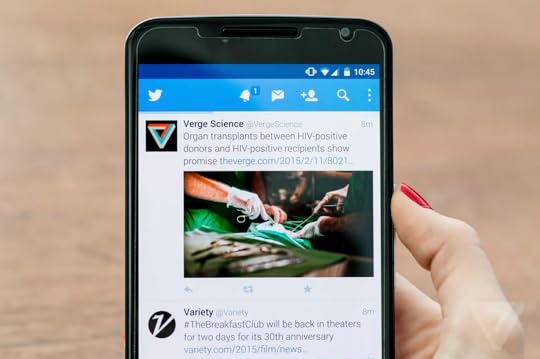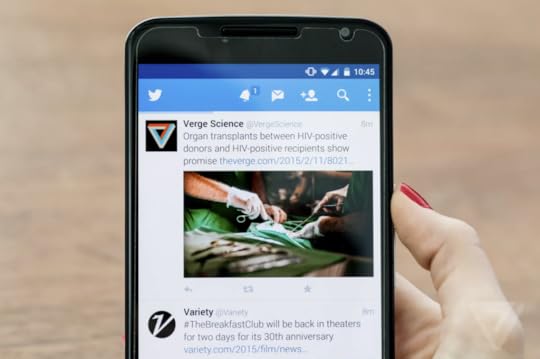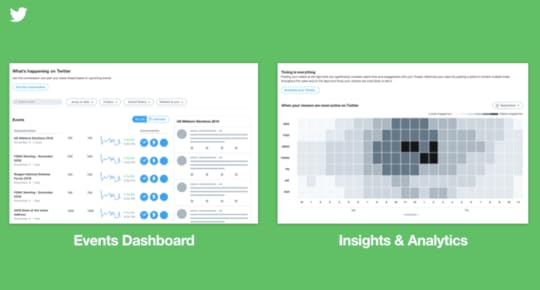Brian Meert's Blog, page 96
January 21, 2019
How to Hide You Facebook Post from a Specific Person
 January 21, 2019
January 21, 2019Anna Hubbel, editor at AdvertiseMint, Facebook marketing agency

At one time or another, we all want to share a post that we don’t want a particular person to see. Whether it’s a friend or boss from work, someone who knows the person you just broke up with, or a family relative who just doesn’t get your sense of humor, there may be someone who you’d rather didn’t see the photo or status you’re dying to post. Thankfully, Facebook allows us to specify who can and can’t see something we share on our profiles for precisely this type of scenario.
Step 1: Navigate to your Facebook profile. Click inside the “What’s on your mind?” space and start creating your post.

Step 2: With the status window open, select where you want your post to appear: News Feed, your Story, or both.

Step 3: After making your selection, click the dropdown menu to the right. Select the “Friends Except” option.

Step 4: Select from your list the friends whom you don’t want to see your post. Select “Save Changes.”

Step 5: If you selected both News Feed and your Story, complete steps four and five for the second option before clicking “Share.”

You’re good to go! Facebook has your back.
By Anna Hubbel , editor at AdvertiseMint, best Facebook advertising agency
The post How to Hide You Facebook Post from a Specific Person appeared first on AdvertiseMint.
January 18, 2019
Twitter to Test Big Changes to App
 January 18, 2019
January 18, 2019Anne Felicitas, editor at AdvertiseMint, Facebook marketing agency
  Charles Deluvio / Unsplash
 Charles Deluvio / Unsplash Most people resent change. When Snapchat changed its app interface last year, many users Tweeted incesed reviews about the new look; some even left the app for rival Instagram. Similarly, users were outraged when Instagram changed the feed from chronological to algorithmic.
Despite users’ resistance to change, Twitter is testing a big update to its app. According to Tech Crunch, Twitter is launching a beta program that allows a few thousand participants to use a standalone app that contains Twitter’s changes.
As reported by Tech Crunch, which has access to the beta program, Twitter is testing color-coded responses to Tweets, with replies from non-followers highlighted in green and replies from the Tweet writer and that writer’s followers highlighted in blue.
 
Twitter’s color-coded responses / Tech Crunch
Twitter is also changing the placement of engagement on Tweets. Engagement icons, such as likes and retweets, will no longer appear on responses. Rather, users must click on specific replies to view the icons. Additionally, replies will be organized algorithmically, with replies from friends appearing at the top.
Adding to the changes with the response threads, Twitter is also changing the timeline by testing pinned Tweets and a status update field that show users’ availability, location, and activity.
Twitter’s efforts may make the app more user-friendly, organized, and seamless, benefitting new users who are not familiar with the app. Yet, the big changes may upset current Twitter users, who are already accustomed to the app’s interface.
Though, the beta test is not under NDA, says Tech Crunch, allowing users to share the test and discuss it with the public. If users don’t like what they’re seeing, Twitter might not roll out the changes. But if it does, let’s hope it doesn’t go in the way of Snapchat.
By Anne Felicitas , editor at AdvertiseMint, Facebook advertising agency reviews
The post Twitter to Test Big Changes to App appeared first on AdvertiseMint.
January 17, 2019
Don’t Panic! What to Do If Someone Is Impersonating You on Facebook
 January 17, 2019
January 17, 2019Anna Hubbel, writer at AdvertiseMint, best Facebook advertising agency
 Glen Carrie / Unsplash
Glen Carrie / Unsplash You’ve heard about it, but you never truly know what it’s like to be impersonated on Facebook until it happens to you. You feel violated and angry, with a desire for justice. Someone is trying to steal your online identity. Something must be done.
Fortunately, Facebook is well aware that catfishing and fake accounts are a common issue on its platform. This article guides you through the process of reporting an imposter, whether you’re a business or brand, a public figure, or simply an individual who wants to preserve the integrity of your Facebook identity.
How to Find Out if Someone Is Impersonating You
To find out if someone is impersonating you on Facebook, Google your name. If the Facebook profile that appears in the search results links to a profile that’s not yours but uses your photos and other personal information, then you have an impersonator. You may also find links for two separate profiles with your name in the search results, one of which is probably an imposter. Click the links to find out.
Friends may also notify you if there’s another profile with your name sending them friend requests. Tell them immediately that the profile isn’t yours and that they should report the account.
How to Report an Imposter Profile
If an imposter profile is pretending to be you, here are the steps to take to report it.
Step 1: Navigate to the impersonating account’s profile. Search for the name the imposter profile uses or have your friends (if they spotted the account) send you the link.

Step 2: Select the three-dot menu at the bottom right corner of the fake profile’s cover page. From the dropdown, select “Give feedback or report this profile.”

Step 3: Complete the on-screen instructions to file a report.

If you do not have a Facebook account, but discover a profile impersonating you, you need to complete the Facebook form that looks like this:

How to Report an Imposter Page
Oftentimes imposters will impersonate an official Facebook page of a public figure, such as a celebrity or politician. It’s worth mentioning that Facebook does not consider opinion or fan pages imposter accounts. But if you come across a fake page that’s impersonating you or another public figure, you should complete this form:

How to Get Verification for Your Page
If you discover an imposter account that copied your business or brand page, or you are a celebrity or public figure, you should get a verification badge. Facebook allows pages to request blue verification badges to let users know that your page is authentic. So even if the imposter page continues to roam Facebook, users will know it’s not really you if it doesn’t have the badge.
Eligibility for a verification badge depends on multiple factors, including account completeness, policy compliance, and public interest. Additionally, your page must comply with Facebook’s terms of service, as well as have the following:
A cover photo
A profile photo
A name that follows Facebook’s guidelines
Content posted to the account
“Follow” enabled (profiles only)
To request a blue verification badge, you’ll need to complete the following steps:
Step 1: Acquire a copy of an official government-issued photo identification (example: passport, driver’s license, national identification card). Have it ready to upload from your computer.
Step 2: Complete Facebook’s “Request a Blue Verification Badge” form through the Facebook Help Center.

Step 3: At the bottom of the form, write a few sentences explaining why the account should receive verification, as well as relevant URLs that illustrate public interest for the account.

Step 4: Select “Send.”

Facebook will send you a notification when it reviews your request. You are only allowed to submit one request for your account. It can take Facebook anywhere between 48 hours to 45 days to process your request.
If Facebook rejects your request for the verification badge, you will need to wait 30 days before submitting a new request. During that time, you should take extra steps to make your profile more complete and authentic, such as linking to your profile or page from your official website, Instagram profile, or Twitter account.
What Happens Next
After you report an imposter account, Facebook will review the report and subsequently take action. Facebook does not allow impersonating accounts, so once it confirms the account is fake, it takes steps towards removing it. According to Facebook’s Help Center, your name and personal information will be kept private. Facebook will not share it with the person impersonating you.
Facebook isn’t clear about how long it takes to review a fake account report or who reviews it. However, the online consensus says Facebook reaches out to the impersonator telling them to remove the account. Additionally, Facebook may advise you to block the fake account so that the imposter cannot collect any additional personal information to use on its fake profile.
The Truth Will Set You Free
Discovering that someone is impersonating you on Facebook may cause you to panic. But take comfort that the truth is on your side. Nothing can change the fact that you are the real you. Facebook wants its users to have positive experiences on its platform, so it will work with you to remove the impersonator. As long as you highlight the truth, that imposter will have no hold on you.
Written by Anna Hubbel, writer at AdvertiseMint, Facebook marketing agency
The post Don’t Panic! What to Do If Someone Is Impersonating You on Facebook appeared first on AdvertiseMint.
January 16, 2019
Reverse-Chronological Twitter Feed Is Coming to Android Devices
 January 16, 2019
January 16, 2019Anne Felicitas, editor at AdvertiseMint, Facebook marketing agency
 Photo courtesy of theverge.com
Photo courtesy of theverge.comHistorically, a switch from reverse chronological to the algorithmic feed results in outrage. When Facebook changed the feed order from time to popularity in 2009, users responded negatively. Similarly, users weren’t so pleased when Instagram and Twitter embraced the algorithmic feed. The latter social media app, particularly, faced a lot of backlash.
To appease its users, Twitter rolled out the reverse-chronological timeline option to iOS users last month. Now, the same timeline option is available to Android users.
Those who own Android devices can switch between seeing popular Tweets to latest Tweets by tapping the sparkle icon on the top-right corner of the app. Rather than forcing all users to adopt one type of timeline, Twitter allows users to choose whichever they prefer, the perfect way to please those who like the algorithmic feed and those who like the reverse chronological feed.
Clearly, Twitter is eager to make changes this year. In addition to the new timeline options, the social media company is also testing big tweaks to its app.
By Anne Felicitas , editor at AdvertiseMint, Facebook advertising agency reviews
The post Reverse-Chronological Twitter Feed Is Coming to Android Devices appeared first on AdvertiseMint.
Here’s Why You Feel the Way You Do When Using These Social Media Apps
 January 16, 2019
January 16, 2019Anna Hubbel, writer at AdvertiseMint, Facebook advertising company

How does Facebook make you feel? Don’t worry, I’m not posing this question to make you delve deep into your emotional psyche and self-evaluate your behaviors. Rather, I pose this question as an interested writer who recently read about a study on how different social media apps make us feel.
Snapchat recently conducted a quantitative and qualitative study of 1,005 app users aged 13 to 44. Snapchat, in the study called Apposphere, partnered with Murphy Research to learn how the top social media apps make us feel. This exploration of the emotions associated with each app provides useful insights behind the reasons we may choose one app over another.
The study uncovered and compared the findings of five social apps: Snapchat, Twitter, YouTube, Instagram, and Facebook. This article will explain the findings for each and offer an analysis on why we feel certain emotions when using particular apps.
Snapchat

According to the study, we primarily use Snapchat when we’re on the move, when we shop, or when we socialize. Using Snapchat usually makes us feel
Silly
Creative
Attractive
Adventurous
Flirtatious
Excited
Happy
Playful
Spontaneous
Unsurprisingly, Snapchat is a feel-good app. Why? Well, in addition to primarily being used to socialize with friends, Snapchat offers an array of fun features, such as lenses and filters. Who can feel sad when wearing a puppy filter of speaking with the voice of a mouse? Snapchat’s filters make it easy to look good in any photo, with softening and brightening capabilities, in addition to long eyelashes, colored lips, and so forth. These fun features are heightened by the ability to share them through photos and videos in a spontaneous moment.
 Marten Bjork / Unsplash
Marten Bjork / Unsplash The results for Twitter had a lot more fluctuation than Snapchat’s. The study says we use Twitter to follow discussions, share views and opinions on topics, and keep up with influencers or celebrities. When using Twitter, we feel
Anxious
Isolated
Overwhelmed
Informed
Flirtatious
Lonely
Self-conscious
Guilty
Depressed
As you can see, there’s a lot more to dissect here, but it makes sense when you consider each emotion. We may feel anxious, overwhelmed, or depressed on Twitter when we’re using it to keep up with news and current events, which can get negative. However, since Twitter is primarily used for news updates, it also makes us feel informed.
Twitter may make us feel isolated or lonely as well because it’s not a very social app. Unlike Snapchat and Instagram, Twitter doesn’t promote friendship as strongly as it promotes following major news outlets and public figures. Our Twitter feeds consist less of photos or videos of friends and more of gifs, witty comments, and news updates.
We may feel self-conscious or guilty when using Twitter when we reply to trending Tweets. Will the Tweet’s creator see your comment? Was your comment witty or interesting enough for all the people who will see it? Did you say something hurtful that you’ll regret later? We also feel self-conscious when we create a Tweet of our own. Will anyone like it or retweet it?
The emotions we feel when we use Twitter are not all doom-and-gloom, however. As previously mentioned, it keeps us informed. But the study identified another emotion we may feel with Twitter: flirtatiousness. Since Tweets are short and snappy, it’s easy to be cute and alluring.
YouTube

Snapchat isn’t the only feel-good app. According to the study, when we use YouTube, we usually feel
Inspired
Captivated
Excited
Informed
Happy
Entertained
Creative
Curious
Smart
We use YouTube for a variety of purposes, like learning about a variety of topics or new products, sharing videos, following pop culture news, or finding products to buy. We want to be the next big vlogger, so we look for inspiration. We want to laugh, so we search for funny content. We want to build or fix something, so we look for how-to videos. We’re studying a complex theory in school, so we find visual explanations. Maybe we’re feeling a little gossipy, so we watch embarrassing videos of celebrities.
 Rawpixel / Unsplash
Rawpixel / UnsplashInstagram is a camera app like Snapchat, so all the emotions associated with it must be the same, right? Actually, no. The study found that Instagram makes us feel
Inspired
Entertained
Adventurous
Smart
Flirtatious
Self-conscious
Creative
Playful
Attractive
As you can see, Instagram is unique because it makes us feel a mix of the emotions we feel with the previously mentioned apps. It may make us feel adventurous, creative, playful, and attractive like Snapchat; informed, flirtatious, and self-conscious like Twitter, or inspired, entertained, and smart like YouTube. These results accurately reflect the app’s diverse nature.
Each of the emotions we may have when using Instagram has a logical explanation. For instance, following an Instagram influencer makes us feel inspired or entertained. In contrast, we feel self-conscious when we compare ourselves to others who post content that depicts their perfect lives or flawless physical appearances. But then we may also feel attractive, playful, and flirtatious using Instagram’s beautifying filters. Similarly, viewing informative or awe-inspiring content makes us feel adventurous, smart, or creative.
The study’s findings showed that we use Instagram to share photos, talk to friends, follow influencers or celebrities, share daily updates, and share videos.
 Tim Bennet / Unsplash
Tim Bennet / UnsplashLast but not least, we have Facebook, the social media giant. Snapchat’s study found that we use Facebook to talk to friends and family, share photos, have private conversations, and learn about events. It also found that Facebook makes us feel
Informed
Overwhelmed
Guilty
Curious
Self-conscious
Connected
Entertained
Isolated
Lonely
Facebook makes us feel informed, isolated, overwhelmed, guilty, and lonely in ways similar to Twitter. We may feel either overwhelmed or informed by the news flooding our feeds. Posting an opinion that subsequent comments suggest is unpopular makes us feel guilty. Sharing an unflattering photo of ourselves or trying to strike the perfect pose for our profile picture makes us feel self-conscious. When we see photos of friends having a fun time together, we feel isolated and lonely.
However, out of all the social apps listed, Facebook is the only one that makes us feel connected. It may not have the fun visual features of Instagram or Snapchat, but Facebook is usually the app we use to stay in touch with family. It’s also commonly used for identifying trending topics, whether that’s the news or topics people are starting to talk more about. We often look to Facebook when researching businesses or brands as well. We explore their Facebook page for more details to determine whether they are reputable. It all ties into this feeling of connection to the world.
Which Apps Are You Using?
The emotions associated with each social app can tell us a lot about ourselves. Which apps do we use most often? Why? As advertisers, we can use this information to learn about our audiences and the platforms we should use to reach them.
“The more apps become a part of our daily lives, the more important it is to gain insight into the role they play in how we behave and feel,” Snapchat concluded. “Understanding how and when you turn to different platforms — and their individual impact — can help you make the choices that are right for you.”
Written by Anna Hubbel, writer at AdvertiseMint, Facebook advertising company
The post Here’s Why You Feel the Way You Do When Using These Social Media Apps appeared first on AdvertiseMint.
January 15, 2019
Amazon’s New Marketing Option Delivers Free Samples to Shoppers
 January 15, 2019
January 15, 2019Anna Hubbel, writer at AdvertiseMint, Facebook advertising company
 Bench Accounting / Unsplash
Bench Accounting / Unsplash Amazon is testing a free-sample program that allows brands to ship product samples to prospective buyers. Brands handle the payment while Amazon uses the customer data it acquired to identify which shoppers are likely to buy. In essence, Amazon will seamlessly bring the free-sample experience to customers’ doorsteps.
How It Works
According to Axios, Amazon will use machine learning and its acquired data about consumer behaviors to select and deliver samples of new products. Samples are delivered to shoppers who are most likely to buy the product.
“Amazon helps you discover products you might love by sending you FREE samples from new and established brands,” Amazon says on its product sampling page. “It’s like Amazon’s product recommendations, but real, so you can try, smell, feel, and taste the latest products. There is no obligation to purchase or review the product and you can opt out at any time.”
Axios believes this new form of targeted and customized advertising could give Amazon a leg up on its top competitors, Google and Facebook. Currently, Amazon falls in third place behind Google and Facebook as a leading digital advertising platform. The new sample program may change that.
The Potential Pros and Cons
Amazon has a massive user base, which has allowed it to accumulate a significant amount of consumer data. Brands that want to participate in Amazon’s free-sample offering will benefit from that data, making it easier to reach customers who are more likely to buy, who are more likely to respond positively to a free surprise at their doorsteps. This new advertising approach goes beyond Amazon’s traditional Display Ads, which account for roughly $5 billion of Amazon’s ad revenue.
One concern consumers have already expressed on social media is privacy. They feel their personal shopping behaviors are being exploited to promote more revenue, reports Axios. Additionally, consumers who have already received samples from brands like L’Oreal’s Maybelline and Folgers could not understand why Amazon selected them. This confusion may reflect a flaw in Amazon’s system for identifying potential buyers.
A New Approach to Advertising
Amazon is already popular for its exceptional online shopping and delivery experiences. Although still in the early stages, the free-sample offering could be a major boost for both Amazon and major brands who want to know more about their Amazon audiences. It’s still too early to predict whether the new advertising option will succeed. However, it will most certainly revolutionize the concept of targeted advertising.
Written by Anna Hubbel, writer at AdvertiseMint, Facebook advertising company
The post Amazon’s New Marketing Option Delivers Free Samples to Shoppers appeared first on AdvertiseMint.
January 14, 2019
Twitter Is Developing Dashboards with Readership Analytics and More
 January 14, 2019
January 14, 2019Anne Felicitas, editor at AdvertiseMint, company for Facebook ads
 Marten Bjork / Unsplash
Marten Bjork / Unsplash According to Tech Crunch, Twitter is developing two dashboards, one that provides readership insights and one that provides real-time event information.
The readership dashboard, which is likely available only to publishers and Twitter business account owners, helps publishers view insights about Twitter readers. For example, The New York Times could see who is reading and engaging with the content it posts to the social media app. The New York Times could also see who views the content and which content performs the best.
When rolled out, the dashboard will help publishers optimize and improve their Twitter campaigns for both sponsored and organic content. There is no word on when it will be available, but Twitter’s VP of Product Keith Coleman did say to Tech Crunch that it is still in the early stages of concept.
 Photo courtesy of Tech Crunch
Photo courtesy of Tech Crunch The events dashboard will be open to all users, appearing on the top of timelines, Explore, and Search. It will show information about upcoming events, including breaking news events. The dashboard helps users remain up to date without following numerous hashtags and accounts. Instead of chasing the news, the news comes to them.
As a platform where news is widely shared, Twitter’s tools, if rolled out, will improve the information-sharing experience. The year has barely begun. What else will Twitter have in store for users this year?
By Anne Felicitas , editor at AdvertiseMint, company for Facebook ads
The post Twitter Is Developing Dashboards with Readership Analytics and More appeared first on AdvertiseMint.
Facebook Is Testing Events on Stories
 December 14, 2018
December 14, 2018Anne Felicitas, editor at AdvertiseMint, Facebook advertising agency
 Priscilla Du Preez / Unsplash
Priscilla Du Preez / Unsplash In another attempt to encourage usage, Facebook is testing events on Stories. The test, which will arrive to iOS and Android devices, will take place in the United States, Mexico, and Brazil.
According to The Verge, users can add tappable stickers that show details about an event. Friends can then respond to the event by toggling themselves as “interested” or “going” without exiting to the event page. From the Story, users can also enter a group chat with friends who RSVPed.
Since its roll out in 2017, Facebook Stories has been scarcely used and ignored altogether by users, who are more interested in Instagram Stories and Snapchat. Determined to boost popularity, the company has tried various methods that encourage use by rolling out CTA buttons for page Stories, allowing News Feed content to post to Stories, and adding the Stories bar to Messenger.
Yet, Stories’ user base is slow to grow. This is a particular setback at a time when Facebook is switching from News Feed-focused to Stories-focused. Slow growth means fewer opportunities to monetize the feature as advertisers have a difficult time making their ads profitable. If users transition from News Feed to Stories, advertisers, profitability, and revenue will follow suit. But with Stories’ tepid performance, those goals won’t come so easily.
Written by Anne Felicitas, editor at AdvertiseMint, Facebook advertising agency
The post Facebook Is Testing Events on Stories appeared first on AdvertiseMint.
January 11, 2019
25 Tools Instagram Content Creators Can’t Overlook
 January 11, 2018
January 11, 2018Anna Hubbel, writer at AdvertiseMint, Facebook ads company
 Raw Pixel / Unsplash
Raw Pixel / Unsplash Instagram is a beautiful platform because it allows content creators like you to share stunning and captivating visuals. But you don’t have to do it alone. Whether you’re an influencer or an Instagram content creator for a specific brand, you can always use some extra help succeeding on the competitive platform. There are so many tools out there that will make your life so much easier. But where do you look? You’re in luck. You can start right here.
Scheduling and Management Tools
 Photo Courtesy of Search Engine Journal
Photo Courtesy of Search Engine JournalYou’re so busy you don’t have time to publish an Instagram post every day. Scheduling tools make it possible to take care of all your Instagram posts in one sitting for the entire week. They also allow you to make sure you publish posts during times of the day when your audience is the most engaged. Here are some useful scheduling tools to help you more productively plan your Instagram posts.
Later
Later allows you to schedule visual content to Instagram. You can add photos to your Later calendar and schedule them to auto publish when you choose. Later is useful if you want to keep your content fresh without producing something every single day.
Zoho Social
Zoho Social is a direct publishing tool that offers a free plan and paid plans that let you add team members and additional features. This tool is particularly helpful if you also want to manage your Twitter, Facebook pages, LinkedIn company pages, and Google+ pages all in one place.
Buffer
Plans start at $15 per month, but the first 10 posts are free. Buffer is useful when you don’t want to worry about publishing reminders or giving confirmation through your mobile device for content to post. You schedule it, and Buffer takes care of the rest.
Hootsuite
Hootsuite lets you schedule up to 30 posts at a time. You can also pay for plans that allow you to schedule even more. Hootsuite is easy to use, and it is great when you want to create and manage all of your Instagram posts for the week in one day.
Tailwind
Tailwind has a drag-and-drop functionality that makes it easy to schedule your Instagram posts in bulk. It also has a Smart Schedule functionality, which automatically recommends the optimal times to post for your particular Instagram account.
Photo Editing Tools
 Unsplash
UnsplashInstagram is all about visuals. The best-performing Instagram posts have stunning photos and images. Poor-quality Instagram photos will hurt your social campaign. Here are some photo editing tools that will help you publish high-quality Instagram photos like a boss.
Snapseed
Snapseed is a free, Google-built app with 26 built-in tools and filters for Instagram photos. It gives you options such as lens blur, HDR Scape, vintage filters, and even separate editing for isolated items in an image.
Adobe Photoshop Express
Adobe Photoshop Express offers the basic tools for getting your photos Instagram ready. It’s easy for quick cropping, rotating, red-eye removal, smoothing, and other touch-ups. It’s free, with the option to make in-app purchases for additional features.
Canva
Canva has templates that are social media ready, as well as tools for adding filters, text, and more. Check out Canva if you want to add more to an image, such as text with funky fonts, backgrounds, borders, or quotes. It’s also perfect if you want those features for free.
piZap
PiZap is a photo editor built specifically for social media images. You easily import photos from any device to edit and share on Instagram. It functions in both HTML5 and Flash, which means you can use it from any device. This tool is perfect if you want to keep things simple with your editing.
Pixlr
Pixlr offers a library of photo editing tools, including blur, sharpen, collage, add text, resize, and even ink drawing or pencil sketch image transformations. If you’ve already got at least the basics down of photo editing but want to take it to the next level, Pixlr can transform the Instagram experience you give to your followers.
Analytics Tools

You can publish Instagram content until your fingers are numb, but how do you know whether your posts are effective? The answer is analytics. As powerful a marketing tool as Instagram, you still need to know what’s working specifically for your Instagram account and campaign goals so that you can make adjustments as needed. Analytics tools provide performance metrics that you can use to inform your campaigns. Here are five analytics tools you should consider.
Iconosquare
Iconosquare allows you to track metrics for multiple Instagram accounts. It includes competitive hashtag and growth tracking and gives you a free audit for your business profiles. The audit analyzes 30 of your most recent business posts while considering your account settings to tell you how well your account is optimized.
Phlanx
Phlanx is an engagement calculator that gives you metrics for Instagram account’s engagement rate. It generates the rate using your account’s number of likes, comments, and followers.
TapInfluence analyzes a database of more than 50,000 influencers, searching for the right influencers for your brand. It also finds rates and cost per engagement for each influencer. If you’re having a hard time finding an influencer to partner with, TapInfluence is a one-stop shop for finding one. You can search by either industry or specific tags, depending on what you want in an influencer.
Curalate
Curalate helps you track user-generated content, providing useful information about how users are responding to your products and social campaigns. The tool tracks engagement, sales, tags, and mentions.
Instagram Insights
Instagram Insights is the platform’s native analytics tool and provides useful, in-depth data. You get metrics for impressions, engagement, reach, and top posts, to name a few. The tool also gives you access to audience demographics, so you get information about your followers, such as gender and geographical location.
File Storage Tools
 Imgix / Unsplash
Imgix / Unsplash With social media data breaches becoming more of a concern these days, it’s always wise to download your Instagram account data and media regularly. But where should you store it? Here are some useful file storage tools for your Instagram content.
Odrive
Odrive is a cloud storage service where you can easily store Instagram content by linking to your account. If you also need cloud storage for other accounts, such as Gmail, Facebook, or Amazon, Odrive will store it all in one place.
OneDrive
OneDrive is Microsoft’s cloud service that functions very similarly to your desktop computer, keeping your files and folders organized. The difference is you can access those files anywhere. OneDrive is ideal if you want to share your Instagram data with other team members.
IDrive
IDrive is a social-specific, online backup provider. For both Facebook and Instagram, IDrive automatically stores copies of your media content on its cloud servers, including tagged content. You can access IDrive from your desktop or mobile devices.
Acronis True Image
Acronis True Image is a fast backup system for Facebook and Instagram, saving content and its likes, comments, and tags. Backup is both continuous and incremental, meaning it automatically saves data that’s new since the last backup. Acronis can restore saved content to a new profile if your account is deleted.
pCloud
pCloud is a cloud storage service that also offers file sync, file sharing, and social media backup services. However, it only saves photos and videos. But what it lacks in service, pCloud makes up for in storage space, with options for a free 10GB account, a 500GB account for five dollars a month, or a 2TB account for eight dollars a month.
URL Shortening Tools
 Le Buzz / Unsplash
Le Buzz / Unsplash Nothing looks more spammy than a long link in the caption of your Instagram post. It also doesn’t look clean or professional. Here are some useful tools for shortening URL links.
Ow.ly
Ow.ly is a Hootsuite tool that shortens URLs. It’s a tool that gets the job done quickly and conveniently, if you already use the Hootsuite platform for your social media management.
Bit.ly
In addition to shortening your links, Bit.ly tracks how many clicks your link gets. This added perk helps inform your Instagram campaign by showing you whether your followers are clicking your link.
Not all URL shorteners offer the option to customize parts of the generated link, but TinyURL does. When shortening your link, you can customize the end letters and numbers. TinyURL is particularly useful to you if branding is a priority for your Instagram campaign. It offers another way to stand out and resonate with users.
Bit.do
Bit.do shortens links, lets you use your own domain and customize the characters at the end of your links, and even provides real-time statistics. On top of that, the tool also shows you which countries the link clicks are coming from. You don’t even need to set up an account to use the service.
This tool offers something that the others do not: monetary rewards. You can earn money for each link click when you use AdF.ly. The tool also offers statistical data for every shortened link when you create an account.
You’re Ready
 Brooke Cagle / Unsplash
Brooke Cagle / UnsplashWith this handy list of tools, you’re ready to kill it on Instagram. You have everything you need to create and measure content that will keep your followers engaged, as well as attract new followers. If you have the drive and positive attitude to put out only the best content, there’s nothing that can stop you.
Written by Anna Hubbel, writer at AdvertiseMint, Facebook ads company
The post 25 Tools Instagram Content Creators Can’t Overlook appeared first on AdvertiseMint.
January 10, 2019
New Instagram Feature Lets You Post to Multiple Accounts
 January 10, 2018
January 10, 2018Anne Felicitas, editor at AdvertiseMint, Facebook advertising agency

Managing multiple Instagram accounts is a tedious task. You have to visit each one to view each analytics, to post content to each feed. Isn’t there a way to efficiently manage several accounts?
Instagram is adding a feature that allows you to simultaneously post feed content to different accounts that you manage. The new feature was first reported by Tech Crunch, to whom an Instagram spokesperson confirmed the roll out.
When preparing an Instagram post, the feature, called Post to Other Accounts, appears under the tagged location bar and contains the accounts to which you can post content. As Tech Crunch reported, Post to Other Accounts will roll out to iOS devices. There’s no word on when it will roll out to Android.
 Photo courtesy of Tech Crunch
Photo courtesy of Tech CrunchPost to Other Accounts isn’t the only Instagram feature that simplifies the sharing process. Instagram currently allows users to post content across three different platforms, Twitter, Tumblr, and Facebook. Yet, Instagram has not rolled out one coveted posting feature: the regram tool.
On September of last year, The Verge reported Instagram was testing a regram feature that allows users to publish friends’ posts to their feeds. Despite seeing screenshots and speaking to a source, The Verge’s rumor was shot down by Instagram. There has been no word of the regram tool since.
Still, could the Post to Other Accounts be a sign of the regram feature to come? Let’s hope so.
Written by Anne Felicitas, editor at AdvertiseMint, Facebook advertising agency
The post New Instagram Feature Lets You Post to Multiple Accounts appeared first on AdvertiseMint.



